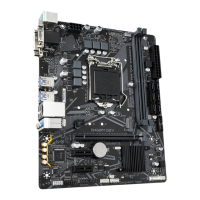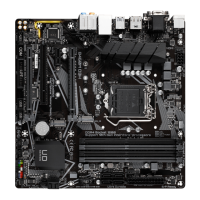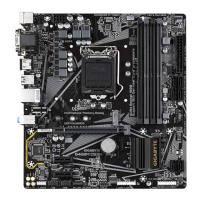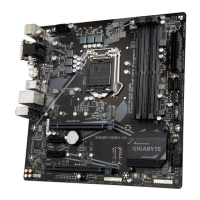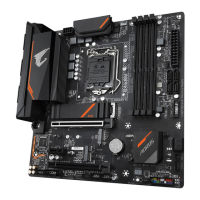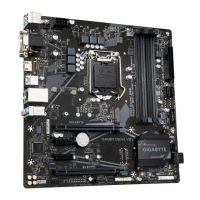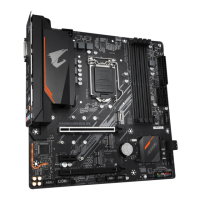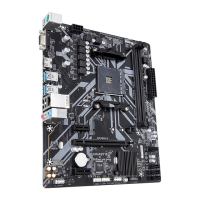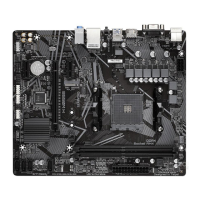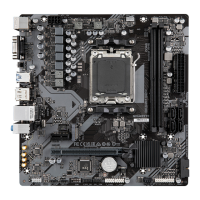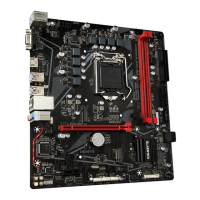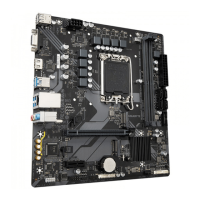Do you have a question about the Gigabyte B460M H and is the answer not in the manual?
Instructions to locate and understand motherboard revision numbers.
Visual diagram of the motherboard layout and connectors.
Details of items included in the product box.
Essential safety guidelines for installing hardware components.
Comprehensive technical details of the motherboard features.
Introduction to internal motherboard connectors.
Detailed procedure for installing the CPU onto the socket.
Guide for installing RAM and configuring dual-channel memory.
Instructions for installing expansion cards into slots.
Identification and function of rear panel ports.
Details on ATX power connectors and fan headers.
M.2, SATA, COM, USB, and audio headers.
Front panel, RGB, TPM, and Clear CMOS headers.
How to enter BIOS, startup screen, and navigation.
Explanation of BIOS menus, function keys, and favorites.
Adjusting CPU clock ratios, memory frequencies, and timings.
Configuring CPU technologies, power saving, and thermal features.
Fine-tuning memory timings and performance settings.
Configuring system power states and wake-up events.
Settings for onboard devices like LAN, audio, and USB.
Configuration of SATA, RAID, NVMe, and miscellaneous options.
Monitoring PC health and managing fan speeds via Smart Fan 5.
View BIOS version, CPU, memory, and device information.
Managing boot order, fast boot, and OS compatibility.
Configuring boot options for USB, PS/2, Network, and legacy devices.
Password protection, Secure Boot, and BIOS mode selection.
Saving, loading, and applying BIOS configurations.
Steps for setting up RAID arrays using BIOS.
Installing and configuring Intel Optane Memory for performance.
Procedure for installing essential system drivers from disc.
Regulatory compliance information for FCC, Canada, and EU.
Information on how to reach GIGABYTE for assistance.
Instructions to locate and understand motherboard revision numbers.
Visual diagram of the motherboard layout and connectors.
Details of items included in the product box.
Essential safety guidelines for installing hardware components.
Comprehensive technical details of the motherboard features.
Introduction to internal motherboard connectors.
Detailed procedure for installing the CPU onto the socket.
Guide for installing RAM and configuring dual-channel memory.
Instructions for installing expansion cards into slots.
Identification and function of rear panel ports.
Details on ATX power connectors and fan headers.
M.2, SATA, COM, USB, and audio headers.
Front panel, RGB, TPM, and Clear CMOS headers.
How to enter BIOS, startup screen, and navigation.
Explanation of BIOS menus, function keys, and favorites.
Adjusting CPU clock ratios, memory frequencies, and timings.
Configuring CPU technologies, power saving, and thermal features.
Fine-tuning memory timings and performance settings.
Configuring system power states and wake-up events.
Settings for onboard devices like LAN, audio, and USB.
Configuration of SATA, RAID, NVMe, and miscellaneous options.
Monitoring PC health and managing fan speeds via Smart Fan 5.
View BIOS version, CPU, memory, and device information.
Managing boot order, fast boot, and OS compatibility.
Configuring boot options for USB, PS/2, Network, and legacy devices.
Password protection, Secure Boot, and BIOS mode selection.
Saving, loading, and applying BIOS configurations.
Steps for setting up RAID arrays using BIOS.
Installing and configuring Intel Optane Memory for performance.
Procedure for installing essential system drivers from disc.
Regulatory compliance information for FCC, Canada, and EU.
Information on how to reach GIGABYTE for assistance.
| Processor socket | LGA 1200 (Socket H5) |
|---|---|
| Processor manufacturer | Intel |
| Compatible processor series | Intel Celeron, Intel Core i3, Intel Core i5, Intel Core i7, Intel Core i9, Intel Pentium |
| Audio chip | Realtek ALC887 |
| Component for | PC |
| Motherboard chipset | Intel B460 |
| Audio output channels | 7.1 channels |
| Motherboard form factor | micro ATX |
| Windows operating systems supported | Windows 10 x64 |
| Memory channels | Dual-channel |
| Memory slots type | DIMM |
| Unbuffered memory | Yes |
| Number of memory slots | 2 |
| Supported memory types | DDR4-SDRAM |
| Maximum internal memory | 64 GB |
| Supported memory clock speeds | 2133, 2400, 2666, 2933 MHz |
| Wi-Fi | No |
| Ethernet interface type | Gigabit Ethernet |
| PCI Express x16 slots | 1 |
| RAID levels | 0, 1, 5, 10 |
| Supported storage drive types | HDD & SSD |
| Supported storage drive interfaces | M.2, SATA III |
| Number of SATA III connectors | 4 |
| Number of Parallel ATA connectors | 0 |
| BIOS type | UEFI AMI |
| ACPI version | 5.0 |
| BIOS memory size | 128 Mbit |
| System Management BIOS (SMBIOS) version | 2.7 |
| USB 2.0 ports quantity | USB 2.0 ports have a data transmission speed of 480 Mbps, and are backwards compatible with USB 1.1 ports. You can connect all kinds of peripheral devices to them. |
| Maximum resolution | 4096 x 2160 pixels |
| Maximum graphics card memory | 512 MB |
| Parallel processing technology support | Not supported |
| Depth | 185 mm |
|---|---|
| Width | 226 mm |
